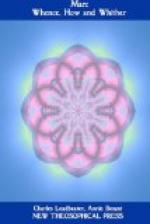Early in this century a farmer, Seth Wright, found among his lambs a young ram with short legs and long body. The farmer kept the ram, reasoning that his short legs would prevent him from leading the flock over the farm-walls and fences. From this ram was descended the breed of ancon, or otter, sheep. Now the stimulus which had excited this variation must have been applied early in embryonic life, or perhaps during the formation or maturing of the germ-cells themselves. Such a variation we call a congenital variation.
These cases are merely illustrations of the general truth that in every variation there are two factors concerned: the living being with its constitution and inherent tendencies and the external stimulus.
The courses of the different balls in a charge of grape-shot, hurled from a cannon, are evidently due to two sets of forces—1, their initial energy and the direction of their aim; 2, the deflecting power of resisting objects or forces—or the different balls might roll with great velocity down a precipitous mountain-side. In the first case velocity and direction of course would be determined largely by initial impulse; in the second, by the attraction of the earth and by the inequalities of its surface.
In evolution, environment, roughly speaking, corresponds to these deflecting or attracting external objects or forces; inherent tendencies to initial impulse. If we lay great weight on initial tendencies, inherent in protoplasm from the very beginning, we shall probably lay less stress on natural selection as a guiding, directing process.
The great botanist, Naegeli, has propounded a most ingenious and elaborate theory of evolution, as dependent mainly on inherent initial tendency. We can notice only one or two of its salient points. All development is, according to his view, due to a tendency in the primitive living substance toward more complete division of labor and greater complexity. This tendency, which he calls progression, or the tendency toward perfection, is the result of the chemical and molecular structure of the formative controlling protoplasm (idioplasm) of the body, and is transmitted with other parental traits from generation to generation. And structural complexity thus increases like money at compound interest. Development is a process of unfolding or of realization of the possibilities of this tendency under the stimulus of surrounding influences. Environment plays an essential part in his system. But only such changes are transmissible to future generations as have resulted from modifications arising in the idioplasm. Descendants of plants which have varied under changed conditions revert, as a rule, to the old type, when returned to the old surroundings. And in the animal world effects of use and disuse are, according to his view, not transmissible.
Natural selection plays a very subordinate part. It is purely destructive. Given an infinity of place and nourishment—do away, that is, with all struggle and selection—and the living world would have advanced, purely by the force of the progressive tendency, just as far as it now has; only there would have survived an indefinite number of intermediate forms. It would have differed from our present living world as the milky way does from the starry firmament.




